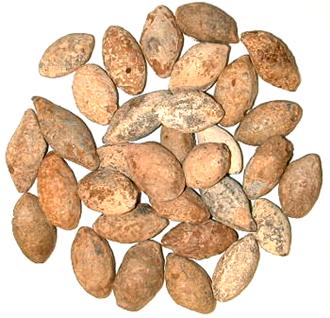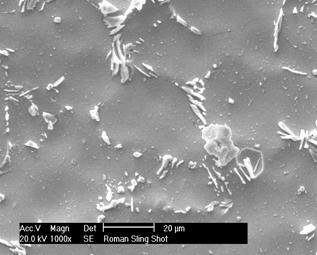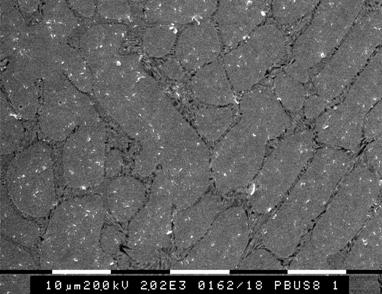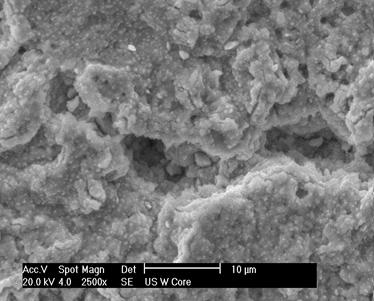 |
|||
| LEAD Action News Volume
13 Number 4, June 2013, ISSN 1324-6011 Incorporating Lead Aware Times ( ISSN 1440-4966) and Lead Advisory Service News (ISSN 1440-0561) The Journal of The LEAD (Lead Education and Abatement Design) Group Inc. Editorial Team: Elizabeth O’Brien, Zac Gethin-Damon, Hitesh Lohani, Shristi Lohani and David Ratcliffe |
|||
|
About Us
|
Environmental Risks Arising from Changes in Ammunition Materials’ Copyright © 2013 – Cylenchar Limited Dr Peter J Hurley – Cylenchar Limited UK The Contaminant – Metallic Lead? In ancient times, hard lead was used for the first lead bullets. These illustrated are circa 1st Century BCE Roman peltast bullets from the Danube valley. They are quite common and usually found in an excellent state of preservation. Take a close look at lead projectiles in the form of polished and un-etched cross-section through an electron microscope, below and we see the polished section shows a metallic shine. The alloy is a ‘unitary’ Lead 4% arsenic alloy. The large crystal grains are only just evident through the presence of a thin layer of arsenic and lead oxides. Not bad for an alloy of circa 2,000 years age.
Lead acid batteries are somewhat misnamed. They derive their electrical properties principally from conversion of lead (II) dioxide to Lead (I) sulphate, which are held in the battery as pastes supported on lead alloy plates. Lead oxides and sulphates comprise approximately half of the weight of the lead in the battery. When battery lead is reprocessed, it undergoes a primary melt and treatment with lime, yielding a molten emulsion of lead metal and lead oxide. In order to convert this material to metal, the smelter must add carbon, (in the form of crude oil, petroleum coke, coke or even old tyres) to obtain a reductive burn. Incomplete processing leaves lead oxides and sulphates in the final product. Naturally, we would expect the degree of residual oxide to compromise alloy stability, as it is after all, part corroded already. This grade illustrated above by no means represents the worst on the market.
How does such material appear on the market? To be blunt - probably for environmental - and ultimately for economic reasons. In the secondary refining process, initially melting batteries gives rise very little pollution. However, the reductive burn to reduce the oxides back to metal results in copious discharges of hot lead contaminated CO2 to atmosphere. Within Europe and North America, with ever tightening restrictions on such discharges and very high costs of installing and running suitable scrubbing facilities, a significant amount of secondary lead processing has been offshored to the developing nations. From the secondary lead processor’s point of view it would be convenient if he could just sell his primary melt material, which is conveniently metallic looking, even if a little paler and pearlescent in appearance than metallic leads. It is after all of comparable density and ballistic performance. That’s if you don’t consider its inferior mechanical properties – especially on impact, and of course it’s questionable corrosion characteristics. Today, effectively what we have in our projectiles as a contaminant is not so much metallic lead as a destabilised lead alloy composite, peppered with oxides and sulphates – essentially comprising a discharged battery plate. If provided with an acidic environment and an electrolyte we will get re-initiation of the electrochemical process and associated physical changes being manifested as accelerated corrosion. Contents
Environmental Risks Arising from Changes in Ammunition Materials Copyright © 2013 – Cylenchar Limited |
||
|
About
Us |
bell
system lead poisoning |
Contact Us
| Council
LEAD Project | egroups | Library
- Fact Sheets | Home
Page | Media Releases |
|||
|
Last
Updated 19 July 2013
Copyright © The LEAD Group Inc. 1991- 2013 PO Box 161 Summer Hill NSW 2130 Australia Phone: +61 2 9716 0014 |
|||


 In
comparison, lead antimony does not form a unitary alloy, and as such creates
the potential for internal redox cell formation and accelerated corrosion.
If we examine current shot manufacture (e.g. left, a South American
brand, circa 2% antimony but containing circa 5% oxide), we can see it has a
somewhat matt texture with a porous dendrite structure. In enlargement,
shrinkage porosity is fully evident (as black areas) caused by withdrawal of
molten antimony rich eutectic during cooling and solidification. The larger
elongated nodules are less rich in antimony, and contaminated with speckles of
lead oxide and sulphate (the white components).
In
comparison, lead antimony does not form a unitary alloy, and as such creates
the potential for internal redox cell formation and accelerated corrosion.
If we examine current shot manufacture (e.g. left, a South American
brand, circa 2% antimony but containing circa 5% oxide), we can see it has a
somewhat matt texture with a porous dendrite structure. In enlargement,
shrinkage porosity is fully evident (as black areas) caused by withdrawal of
molten antimony rich eutectic during cooling and solidification. The larger
elongated nodules are less rich in antimony, and contaminated with speckles of
lead oxide and sulphate (the white components). Right is material, from a
new manufactured bullet core, its circa 20% plus PbO and is evidently
unrefined solid lead metal/oxide emulsion. The polished cross-section
doesn’t even resemble metal at this magnification.
It looks more like a crumbly grain biscuit marketed as a ‘hob-knob’
in the UK. Quite clearly we wouldn’t expect this product to have the same
impact and corrosion characteristics as refined lead alloy.
Right is material, from a
new manufactured bullet core, its circa 20% plus PbO and is evidently
unrefined solid lead metal/oxide emulsion. The polished cross-section
doesn’t even resemble metal at this magnification.
It looks more like a crumbly grain biscuit marketed as a ‘hob-knob’
in the UK. Quite clearly we wouldn’t expect this product to have the same
impact and corrosion characteristics as refined lead alloy.